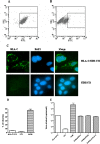Identification of major histocompatibility complex class I C molecule as an attachment factor that facilitates coronavirus HKU1 spike-mediated infection
- PMID: 18987136
- PMCID: PMC2612401
- DOI: 10.1128/JVI.01387-08
Identification of major histocompatibility complex class I C molecule as an attachment factor that facilitates coronavirus HKU1 spike-mediated infection
Abstract
Human coronavirus HKU1 (HCoV-HKU1) is a recently discovered human coronavirus associated with respiratory tract infections worldwide. In this study, we have identified the major histocompatibility complex class I C molecule (HLA-C) as an attachment factor in facilitating HCoV-HKU1 spike (S)-mediated infection. HCoV-HKU1 S pseudotyped virus was assembled using a human immunodeficiency virus type 1-derived reporter virus harboring the human codon-optimized spike of HCoV-HKU1. We identified human alveolar epithelial A549 cells as the most susceptible cell line among those tested to infection by HCoV-HKU1 S pseudotypes. A549 cells were shown to bind purified soluble HCoV-HKU1 S(1-600) glycopeptide. To search for the functional receptor for HCoV-HKU1, an A549 cDNA expression library was constructed and transduced into the nonpermissive, baby hamster kidney cells line BHK-21. Transduced cells that bind soluble HCoV-HKU1 S(1-600) glycoprotein with C-terminal FLAG were sorted. Sequencing of two independent clones revealed cDNA inserts encoding HLA-C. Inhibition of HLA-C expression or function by RNAi silencing and anti-HLA-C antibody decreased HCoV-HKU1 S pseudotyped virus infection of A549 cells by 62 to 65%, whereas pretreatment of cells with neuraminidase decreased such infection by only 13%. When HLA-C was constitutively expressed in another nonpermissive cell line, NIH-3T3, quantitative PCR showed that the binding of HCoV-HKU1 S pseudotyped virus to cell surfaces was increased by 200-fold, but the cells remained nonsusceptible to HCoV-HKU1 S pseudotyped virus infection. Our data suggest that HLA-C is involved in the attachment of HCoV-HKU1 to A549 cells and is a potential candidate to facilitate cell entry. However, other unknown surface proteins on A549 cells may be concomitantly utilized by S glycoprotein of HCoV-HKU1 during viral entry. Further studies are required to elucidate other putative receptors or coreceptors for HCoV-HKU1 and the mechanism of HCoV-HKU1 S-mediated cell entry.
Figures







References
-
- Chan, C. M., P. C. Woo, S. K. Lau, H. Tse, H. L. Chen, F. Li, B. J. Zheng, L. Chen, J. D. Huang, and K. Y. Yuen. Spike protein of human coronavirus HKU1: role in viral life cycle and antibody detection. Exp. Biol. Med. (Maywood), in press. - PubMed
-
- Chang, L. J., V. Urlacher, T. Iwakuma, Y. Cui, and J. Zucali. 1999. Efficacy and safety analyses of a recombinant human immunodeficiency virus type 1 derived vector system. Gene Ther. 6715-728. - PubMed
Publication types
MeSH terms
Substances
LinkOut - more resources
Full Text Sources
Research Materials

